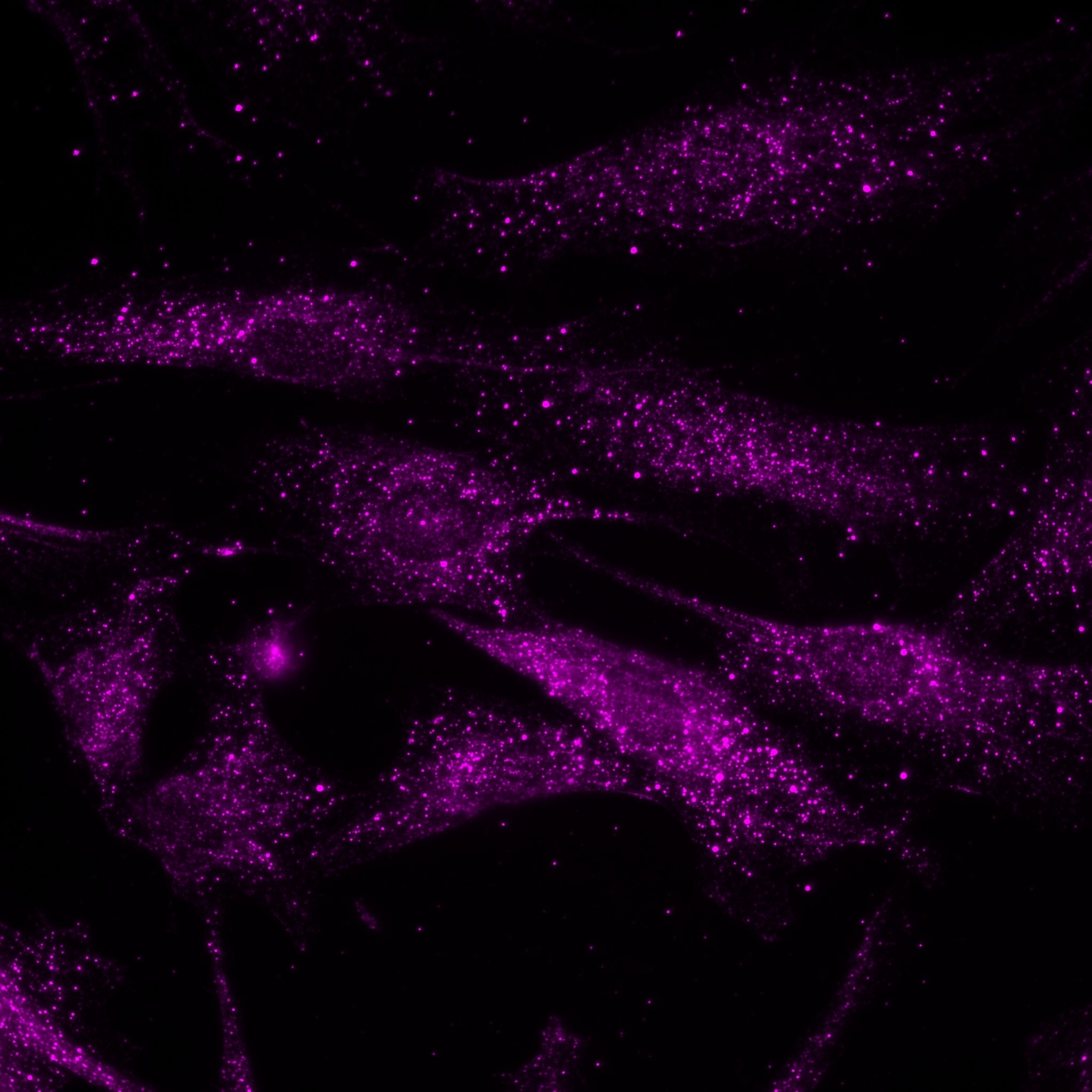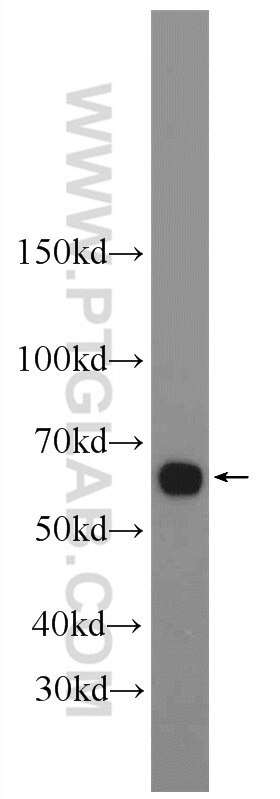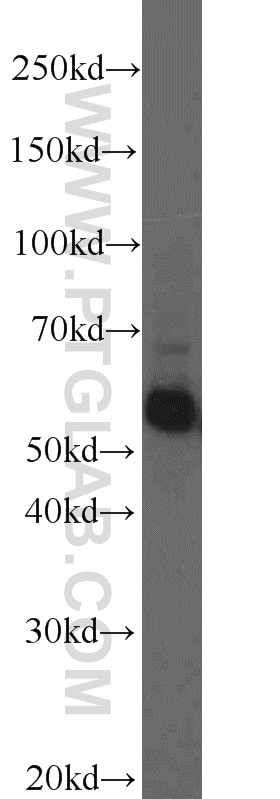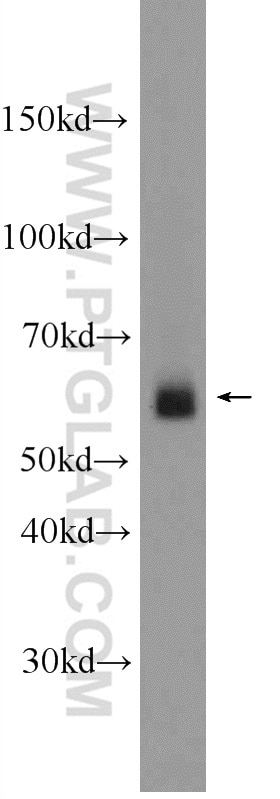- Phare
- Validé par KD/KO
Anticorps Polyclonal de lapin anti-Frizzled 7
Frizzled 7 Polyclonal Antibody for WB, IP, IHC, ELISA
Hôte / Isotype
Lapin / IgG
Réactivité testée
Humain, souris
Applications
WB, IHC, IF, IP, CoIP, RIP, ELISA
Conjugaison
Non conjugué
N° de cat : 16974-1-AP
Synonymes
Galerie de données de validation
Applications testées
| Résultats positifs en WB | tissu de muscle squelettique de souris, tissu cardiaque de souris, tissu rénal de souris |
| Résultats positifs en IP | tissu de muscle squelettique de souris |
| Résultats positifs en IHC | tissu d'intestin grêle humain, il est suggéré de démasquer l'antigène avec un tampon de TE buffer pH 9.0; (*) À défaut, 'le démasquage de l'antigène peut être 'effectué avec un tampon citrate pH 6,0. |
Dilution recommandée
| Application | Dilution |
|---|---|
| Western Blot (WB) | WB : 1:500-1:2000 |
| Immunoprécipitation (IP) | IP : 0.5-4.0 ug for 1.0-3.0 mg of total protein lysate |
| Immunohistochimie (IHC) | IHC : 1:400-1:1600 |
| It is recommended that this reagent should be titrated in each testing system to obtain optimal results. | |
| Sample-dependent, check data in validation data gallery | |
Applications publiées
| KD/KO | See 2 publications below |
| WB | See 12 publications below |
| IHC | See 2 publications below |
| IF | See 2 publications below |
| CoIP | See 1 publications below |
| RIP | See 1 publications below |
Informations sur le produit
16974-1-AP cible Frizzled 7 dans les applications de WB, IHC, IF, IP, CoIP, RIP, ELISA et montre une réactivité avec des échantillons Humain, souris
| Réactivité | Humain, souris |
| Réactivité citée | Humain, souris |
| Hôte / Isotype | Lapin / IgG |
| Clonalité | Polyclonal |
| Type | Anticorps |
| Immunogène | Frizzled 7 Protéine recombinante Ag9446 |
| Nom complet | frizzled homolog 7 (Drosophila) |
| Masse moléculaire calculée | 574 aa, 64 kDa |
| Poids moléculaire observé | 64 kDa |
| Numéro d’acquisition GenBank | BC015915 |
| Symbole du gène | Frizzled 7 |
| Identification du gène (NCBI) | 8324 |
| Conjugaison | Non conjugué |
| Forme | Liquide |
| Méthode de purification | Purification par affinité contre l'antigène |
| Tampon de stockage | PBS with 0.02% sodium azide and 50% glycerol |
| Conditions de stockage | Stocker à -20°C. Stable pendant un an après l'expédition. L'aliquotage n'est pas nécessaire pour le stockage à -20oC Les 20ul contiennent 0,1% de BSA. |
Informations générales
Frizzled class receptor 7 (Frizzled 7, also known as FZD7) is a member of the superfamily of G protein-coupled receptor proteins that act as receptors in the Wnt signaling pathway. Frizzled 7 plays a role in development, stem cell renewal, and differentiation and has been implicated in the progression of various cancers.
What is the molecular weight of Frizzled 7? Is Frizzled 7 post-translationally modified?
The molecular size of Frizzled 7 is ~63 kDa, which represents the mature N-glycosylated species (PMID: 25274627). Frizzled 7 can form homodimers and heterodimers with other Frizzled family members (PMID: 14688793).
What is the subcellular localization of Frizzled 7?
Frizzled 7 is a seven-pass transmembrane protein that is present at the plasma membrane. In endothelial cells, it predominantly locates to cell-cell junctions (PMID: 24866384). Frizzled 7 has a cleavage site for calpain-1 protease in its C-terminus that regulates its activity and plasma membrane turnover (PMID: 17716656).
What is the tissue expression pattern of Frizzled 7?
Frizzled 7 is expressed at high levels in adult skeletal muscles and in fetal kidneys, but is also present in fetal lung, adult heart, brain, and placenta (PMID: 9813155). Frizzled 7 expression is increased in various cancer types, including melanoma, hepatocellular carcinoma, lung, esophageal, gastric, and colon cancers.
Protocole
| Product Specific Protocols | |
|---|---|
| WB protocol for Frizzled 7 antibody 16974-1-AP | Download protocol |
| IHC protocol for Frizzled 7 antibody 16974-1-AP | Download protocol |
| IP protocol for Frizzled 7 antibody 16974-1-AP | Download protocol |
| Standard Protocols | |
|---|---|
| Click here to view our Standard Protocols |
Publications
| Species | Application | Title |
|---|---|---|
Adv Mater m6 A Reader YTHDF1-Targeting Engineered Small Extracellular Vesicles for Gastric Cancer Therapy via Epigenetic and Immune Regulation | ||
Cell Death Differ Cripto-1 contributes to stemness in hepatocellular carcinoma by stabilizing Dishevelled-3 and activating Wnt/β-catenin pathway. | ||
Mol Syst Biol Systematic protein-protein interaction mapping for clinically relevant human GPCRs. | ||
Arch Med Res RNA-binding Protein QKI Inhibits Osteogenic Differentiation Via Suppressing Wnt Pathway | ||
Apoptosis YTHDF1-mediated m6A modification promotes cisplatin resistance in ovarian cancer via the FZD7/Wnt/β-catenin pathway |
Avis
The reviews below have been submitted by verified Proteintech customers who received an incentive for providing their feedback.
FH Susanne (Verified Customer) (04-17-2023) |
 |
FH Louisiane (Verified Customer) (08-11-2022) | Tissues (small intestine sections) were incubated with primary antibody over the weekend at 4C and with secondary antibody overnight at 4C. The signal looks good
|







